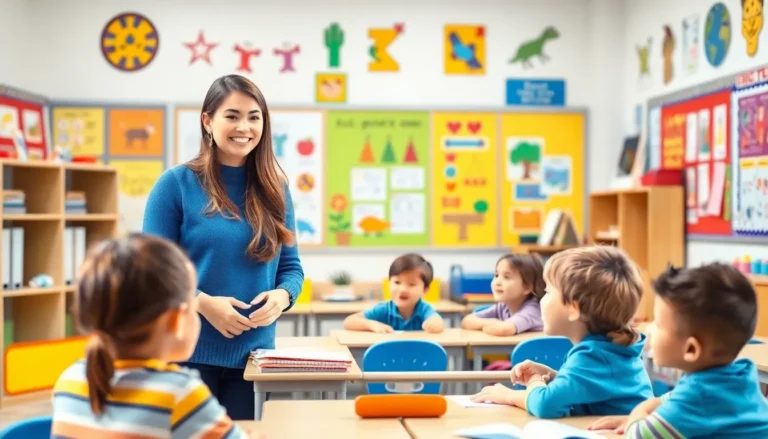The elementary school years are like the opening act of a grand play—filled with laughter, discovery, and a few awkward moments that everyone remembers fondly. From learning to tie shoelaces to mastering multiplication tables, these formative years shape not just academic skills but also social interactions and lifelong friendships. Who could forget the thrill of a first field trip or the chaos of lunchtime?
Table of Contents
ToggleOverview Of Elementary School Years
Elementary school years serve as a crucial foundation for children’s education and personal growth. Students typically range from ages five to eleven during these years, encompassing grades kindergarten through fifth. Academic skills develop in core subjects like reading, writing, and mathematics. Additionally, social skills thrive through classroom interactions and group activities.
Friendships formed in elementary school often last well beyond these formative years. Children learn to share, collaborate, and resolve conflicts, which contributes to emotional intelligence. Memorable experiences, such as field trips, school plays, and sports events, enrich the learning environment and create lasting memories.
Curriculum design varies across schools, but common subjects include science, social studies, and art. Specialized programs may also exist to enhance learning, like music or foreign language classes. Such diversifications allow for holistic development.
Learning continues outside of the classroom, as parents play an integral role in supporting educational growth. Homework helps reinforce classroom lessons, while participation in extracurricular activities fosters teamwork. Parents can encourage exploration of interests that spark a passion for learning.
Teaching methods adapt over time, embracing diverse learning styles. Educators use hands-on activities, technology integration, and collaborative projects to engage students effectively. Instruction focuses on critical thinking and problem-solving skills essential for future academic success.
These elementary years cultivate a sense of curiosity and a love for learning. Children gain confidence through achievements, whether academic or personal. With the right support, the elementary school experience lays the groundwork for lifelong learning and development.
Key Developmental Milestones

Elementary school years mark critical stages in a child’s growth, highlighting the importance of cognitive, social, and emotional development. These milestones shape the foundation for future learning and interactions.
Cognitive Development
Cognitive development during these years focuses on critical thinking and problem-solving skills. Children refine their abilities to understand concepts in mathematics, reading, and writing. They also develop executive functions, allowing them to plan, organize, and carry out tasks. Activities in the classroom, such as hands-on experiments and group projects, encourage inquiry-based learning. This approach promotes creativity and independent thinking, vital for lifelong success. Children at this stage often begin to make connections between ideas, enhancing their comprehension and retention.
Social and Emotional Growth
Social and emotional growth occurs through interactions with peers and teachers. Relationships formed during this time often lead to lifelong friendships. Children learn skills such as empathy, cooperation, and conflict resolution through group activities. Emotional regulation also develops as they navigate various social situations. Supportive classroom environments foster a sense of belonging and confidence, encouraging risk-taking in learning. Positive reinforcement from adults plays a crucial role in enhancing self-esteem and motivation. Overall, these experiences contribute significantly to a child’s emotional intelligence, preparing them for future challenges.
The Role of Teachers and Educators
Teachers and educators play a pivotal role in shaping experiences during the elementary school years. Their influence extends beyond academics, guiding children’s social and emotional development.
Teaching Methods
Innovative teaching methods cater to various learning styles. Hands-on activities engage students, sparking curiosity and promoting deeper understanding. Inquiry-based learning encourages critical thinking, pushing children to ask questions and seek answers. Collaborative projects foster teamwork, supporting the development of social skills. Differentiated instruction addresses individual needs, allowing each student to thrive at their own pace. Daily integration of technology enhances engagement, preparing children for a digital world.
Classroom Environment
A supportive classroom environment cultivates a sense of belonging. Positive relationships among peers and educators enhance self-esteem and motivation. Classroom layouts promoting movement encourage active participation, making learning dynamic. Colorful displays of student work foster pride and ownership over learning. Establishing routines creates a structured environment, aiding in emotional regulation. When rules and expectations are clear, children feel secure in exploring ideas and taking risks.
Parental Involvement
Parental involvement plays a vital role in children’s success during elementary school years. Engaging with schools strengthens the home-school connection and enhances student learning experiences.
Communication with Teachers
Effective communication with teachers supports a child’s academic growth. Parents should maintain regular contact through emails, conferences, or phone calls. Sharing observations about a child’s interests and challenges helps educators tailor their approach. Attending school events fosters collaboration and strengthens relationships. Schools often encourage open dialogue, making it easier for parents to advocate for their children’s needs. Understanding the curriculum enhances discussions and enables parents to reinforce lessons at home. Staying informed about school policies and activities creates a trustworthy environment for children.
Supporting Learning at Home
Supporting learning at home complements classroom instruction significantly. Creating a structured routine allows for dedicated homework and study time. Designating a quiet, well-lit space encourages focus during learning activities. Parents can utilize educational resources, such as books, games, and online tools, to make learning enjoyable. Engaging in discussions about school topics promotes critical thinking and curiosity. Emphasizing the importance of reading at home strengthens language skills. Encouragement of exploration through projects or hobbies fosters a sense of independence. These practices contribute to a child’s overall academic success and personal growth.
Extracurricular Activities
Extracurricular activities play a significant role in enriching the elementary school experience. They provide students with opportunities to explore interests outside the standard curriculum. Programs such as sports, music, art, and clubs foster teamwork and creativity, allowing children to discover their passions.
Children can join sports teams, which enhance physical skills and promote healthy competition. Participation in music or art programs cultivates artistic talents and self-expression. Clubs focused on science, literature, or community service engage students in hands-on projects, strengthening problem-solving and critical thinking skills.
The benefits of extracurricular activities extend beyond personal development. Social interactions in these settings help build friendships and improve communication skills. Engaging in diverse activities encourages cooperation, as children learn to work together and appreciate different perspectives.
Parents play a vital role by supporting their children’s involvement. Encouragement to participate in various activities nurtures exploration and curiosity. Communication with teachers about opportunities available at school enhances parental engagement, reinforcing the importance of a well-rounded education.
Studies show that students involved in extracurricular activities often demonstrate improved academic performance. The skills gained through these activities translate into better time management and organization. Children often feel a greater sense of belonging, contributing to their emotional well-being and motivation.
Extracurricular activities complement academic learning and aid in the holistic development of children. By participating in a range of programs, students develop essential life skills while forming lasting friendships, which are crucial during the elementary school years.
The elementary school years serve as a crucial foundation for children’s future. They blend academic learning with social development in a vibrant environment. These formative years shape not only essential skills but also foster lasting friendships and emotional intelligence.
Parental involvement plays a pivotal role in enhancing children’s experiences during this time. Engaging with educators and supporting learning at home reinforces the importance of education. Extracurricular activities further enrich this stage, allowing children to explore their interests and develop teamwork skills.
Ultimately, the experiences and lessons learned during elementary school create a pathway for lifelong growth and success. By nurturing curiosity and a love for learning, these years set the stage for a bright future.






